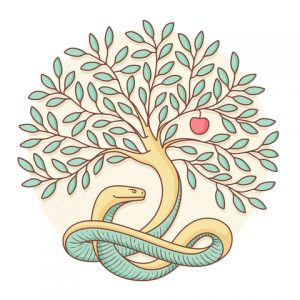
Shownotes
Welcome to Day 1496 of our Wisdom-Trek, and thank you for joining me.
I am Guthrie Chamberlain, Your Guide to Wisdom
Imaging After The Fall and New Testament Application – Worldview Wednesday
Wisdom - the final frontier to true knowledge. Welcome to Wisdom-Trek! Where our mission is to create a legacy of wisdom, to seek out discernment and insights, to boldly grow where few have chosen to grow before. Hello, my friend, I am Guthrie Chamberlain, your captain on our journey to increase Wisdom and Create a Living Legacy. Thank you for joining us today as we explore wisdom on our 2nd millennium of podcasts. Today is Day 1496 of our Trek, and it is Worldview Wednesday. Creating a Biblical Worldview is essential to have a proper perspective on today’s current events. To establish a Biblical Worldview, you must have a proper understanding of God and His Word. This week, on our Worldview Wednesday episode, we will continue our study based on a course I recently completed taught by Dr. Michael Heiser. Our study is titled “Sons and Daughters of God: The Believer’s Identity, Calling, and Destiny” Throughout this multi-week course, we will demonstrate that, in the Old Testament, “sons of God” and “holy ones” refers to supernatural beings whose Father is God and who work with God to carry out His will and that this divine family was present before humanity. By fully engaging with biblical texts such as Psalm 82; Psalm 89, and Deuteronomy 32:8–9, our study will show that this divine family functions as a template for God’s human family. God desires of humans, as His imagers, to participate in His council. This study addresses issues such as polytheism, the nature of the (little ‘g’) “gods,” and Yahweh’s uniqueness. This study will apply insights to the New Testament texts and show how the metaphor of being in God’s family informs our sense of identity and mission as believers.
Imaging After The Fall and New Testament Application
· Segment 26: Imaging After the Fall
Image Remains After The Fall
If the image of God is about us being representatives of God, the fall, the entrance of evil into the world, is certainly a factor in our understanding. Our understanding is that we continue with our purpose. I’ve met Christians that believe that after the fall, the imaging idea was totally lost. Those Christians surmise the only people who image God now are Christians or believers because they’ve been brought back to a relationship with God through redemption. I don’t believe that. I think that’s an inferior understanding of the text and leads to some dangerous theology.
For instance, in Genesis 9:6-7, which, of course, is after the fall, it’s after the flood—we read this, If anyone takes a human life, that person’s life will also be taken by human hands. For God made human beings in his own image. Now be fruitful and multiply, and repopulate the earth.” This is an obvious reference to Eden with the Edenic commands repeated. The commands that were originally given to Adam and Eve, the original imagers. The idea here is that the death penalty, taking the life of a person, is legitimized somehow, and we’re going to find out in the rest of the Torah when that situation might be the case. That idea is legitimized because God cannot tolerate the unlawful, unwarranted taking of any human life. After all, those humans are created in His own image. When you kill a person, it’s like killing God in effigy.
If the image were linked only to Christians or only believers, then this verse would, in effect, be saying, “Well, it’s only a crime if you kill someone who’s a Christian. You can kill other people, and God is not going to care about it, but only if you kill His children, then we’re in trouble.” That’s an absurdity, but this is where some thinking goes. We don’t want to go there. We want to be consistent.
The image of God is something that remains intact even after the fall. It’s important to God because we are His representation; we are His representatives—every human being is at every stage. By definition, if you are human, you are an imager of God, and this is what the biblical mindset is.
Humans Never Co-Rulers in Mesopotamian Religion
This concept is quite a bit different than ancient Near Eastern thinking about humans. Humanity as a collective in other religions—like Mesopotamian religion, even Egyptian religion. Some of these ancient Near Eastern cultures—humanity is never described as having this destiny of being with God or the gods, ruling with them in a positive co-rulership kind of relationship. No. Only the king in many of these cultures ever gets referred to as a particular god’s image. Genesis, of course, specifically Genesis 1:26 with the whole idea that all humanity images God, widens this considerably. Human beings in biblical theology are all equally God’s imagers, not just one person, not just someone with royal blood, but everyone.
God’s Program to Restore
Biblical theology dramatically democratizes the idea. After the fall, we have a problem. We need to bring back the estranged children, humans, back into God’s family. They don’t lose the image; they don’t lose the status of being His representative, but they’re in rebellion. So, something has to be done about that. After the fall, God’s program is to restore Eden, which means restoring His presence on earth, restoring His rule to earth, and the mechanism for doing that is people.
We know the biblical story. Genesis 3 is just the first in a series of rebellions. In this entire course, we focus on the rebellions both in the human and the supernatural world. The Bible covers three rebellions in the first 11 chapters of Genesis. Genesis 3 – the fall of humanity; Genesis 6 – the corruption with supernatural entities; and Genesis 11, the Tower of Babel event. After that, we have the whole problem with Israel and the wilderness wanderings. We have the period of the judges. We have the divided monarchy, idolatry. It’s a long, long road, a long, long story of rebellion. At each phase of this, though, God is trying to restore Eden.

Role of Israel and the Messiah
When we get to the Israelites, this is probably the most straightforward example to see. God has called out for Himself from nothing a new people, the people allotted to Him. His own inheritance is Israel after dispersing all of the other people into nations, assigning them to lesser gods that we talked about earlier.
Here, the story takes one people group that God creates out of nothing miraculously through Abraham and Sarah to reinstall what was lost in Eden. He’s going to dwell with them. They’re going to occupy a specific place. There’s going to be eventually, altars, tabernacles, and temples. God is going to live there. They will be His people. Back in Genesis 12, God told Abraham that “it’s through your seed that all of the nations will be blessed.” They will be brought back into a relationship. It takes a long time for this to work out, and ultimately, it only works out because of the Messiah, because God Himself, becomes a man to ratify and fulfill all of His own covenants to bring all of this about.
So the biblical story here as it relates to human imagers’ issue is that God is committed to working with people, with humans, and it is a long, arduous task. They have to be redeemed; nations have to be reunited; sin and rebellion must be rolled back; the kingdom has to be restored to earth. It is a long, terrible, but also a glorious process. This is the biblical story; it’s the biblical epic of how this is happening.
The Messiah is the key, the linchpin here. He’s both human and divine. He has an atoning death that fixes the problem of Genesis 3. We have a resurrection that ultimately fixes the problem of sinful flesh: getting new bodies, the reclaiming of the nations because the resurrection, in Paul’s thinking, is also key to the defeat of the principalities and powers. All of these things are interconnected and equally important. They all roll around, revolve around, God’s commitment to using people and not exempting them or destroying them.
Humanity’s Freedom Means No Plan B
Now, think about it. God made humanity His imager. They sin. They use one of the attributes that He has shared with them (His freedom of choice) to rebel. God is omniscient; He knows this is going to happen. But He allows it to happen. Why? Because He hasn’t created us as robots. Without an attribute like freedom, without God sharing His characteristics with us, we wouldn’t represent Him. The fact that freedom is one of those attributes means, again, that without it, if we weren’t free in some sense to make decisions to obey or not, we wouldn’t be like Him; we couldn’t be spoken of as His imager because He is not a robot. He is free.
So God is willing to work with humanity in this way; we can say to take this risk. With God, it’s not a risk because He knows the end from the beginning. But this is the biblical story. There is no plan B. God is committed to humanity, to making humanity an intimate, participatory part of everything He wants to do on this planet. There is no plan B.
This is why we have evil; it’s why evil ultimately is going to be redeemed, because God is committed to it. So we are His imagers. We are His means of turning evil into good. We are His means of restoring Eden. We have a status as His family members; we are His children.
Humanity’s Genuine Role
If we are estranged from God, we need to go back into that right relationship again through the work of Christ, and as we do, we can see why we are here, why we are members of His family. We’re able to see that this was God’s original desire, and it should be normal. Once we get that realization, we can have a sense that we have not just a contrived, pretend, artificial role in accomplishing God’s will as though everything was preprogrammed. It’s not. Our role is genuine, and God is committed to making us part of what He wants to do. All of these thoughts are present in the New Testament, but they derive from the material that we’ve been talking about: our status as family members, the concept of imaging. It gives us status, a calling, and, ultimately, a destiny.
· Segment 27: New Testament Application of These Ideas

Introduction
We’ve covered a lot of ground in the Old Testament about the sons of God—this divine family language that we run across in the Old Testament and how humans were included in that family. We went to Genesis 1 for that, and that also took us into the matter of the image of God. We talked about how the plural and singular language interplay in Genesis 1:26–27 sort of fused or united or at least created a strong association between God and His heavenly family and His earthly family and why that was intentional. It was really about imaging God. Both God’s divine family and God’s human family, of course, have the same creator, the same Father, as it were, and that Father tasks us and tasks them in specific ways in their spheres of influence, spiritual world, or the physical world.
Introducing Christ as the Ultimate Imager of God
We want to transition now to how the New Testament repurposes this kind of language. We’re going to talk about Jesus—how He is cast as the ultimate imager of God. Remember that we talked about the image being really kind of a verbal idea rather than a thing put in a person or a quality. It’s a status and the status of representing God. Well, Jesus is the ultimate example of that, and there are New Testament passages that testify to that fact and help solidify our understanding of what imaging means.
Introducing New Testament Vocabulary Regarding Believers
We’re also going to be looking at New Testament vocabulary for believers as children of God. Some passages will be familiar; some may not be so familiar. We will learn how the children of God need to be conformed to the image of the ultimate imager, conformed to the image of Christ. He is our model for how we represent God as family members and really as His siblings.
We’re going to be talking about glorification as well. Glorification is the endpoint for sanctification. We typically talk about the word sanctification: that is, being made divine. It’s being made like Jesus and, of course, being made like a spiritual being, a spiritual family member, but still being embodied. Jesus, even after the resurrection, gets a body, and as we learned in 1 Corinthians 15, our body post-resurrection will be like the body that Jesus had after the resurrection.
Summary
This is all intentional to put us all in the same group with Him as family members, which is the way it was intended to be. Had there never been a fall, this is what we would have been looking like—sort of a jet start, a jump to glorification, solidifying our status as people, embodied beings, humans that belong in God’s family, in His direct presence. Of course, we’ve had this long interval (the biblical story) about how things were fixed after the fall, how God never gave up on that plan.
Ultimately, of course, we’re going to re-inherit all of that as believers, working our way back to Eden, moving forward into the past, as it were. We’ll discuss a little bit about our inheritance of a new Eden that brings all of this together. So that’s where we’re headed in the rest of the course, building on this language, these concepts, that we’ve seen in the Old Testament.[1]
That will finish our study for this week’s Worldview Wednesday. Next week we will cover “Believers as Family, Participants.” Tomorrow we will enjoy our 3-minute Humor nugget that will provide you with a bit of cheer, which will help you to lighten up and live a rich and satisfying life. So encourage your friends and family to join us and then come along with us tomorrow for another day of ‘Wisdom-Trek, Creating a Legacy.’

If you would like to listen to any of our past 1495 treks or read the Wisdom Journal, they are available at Wisdom-Trek.com. I encourage you to subscribe to Wisdom-Trek on your favorite podcast player so that each day’s trek will be downloaded automatically.
Thank you so much for allowing me to be your guide, mentor, and, most of all, your friend as I serve you in through this Wisdom-Trek podcast and journal.
As we take this Trek together, let us always:
- Live Abundantly (Fully)
- Love Unconditionally
- Listen Intentionally
- Learn Continuously
- Lend to others Generously
- Lead with Integrity
- Leave a Living Legacy Each Day
I am Guthrie Chamberlain….reminding you to ’Keep Moving Forward,’ ‘Enjoy your Journey,’ and ‘Create a Great Day…Everyday’! See you Tomorrow!
[1] Heiser, M. S. (2019). Sons and Daughters of God: The Believer’s Identity, Calling, and Destiny. Bellingham, WA: Lexham Press.